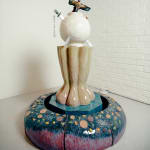Shayne Phua
Further images
-
(View a larger image of thumbnail 1
)

-
(View a larger image of thumbnail 2
)

-
(View a larger image of thumbnail 3
)

-
(View a larger image of thumbnail 4
)

-
(View a larger image of thumbnail 5
)

-
(View a larger image of thumbnail 6
)

-
(View a larger image of thumbnail 7
)

-
(View a larger image of thumbnail 8
)

This work is one of several ceramic fountains created for the present exhibition, and the largest. In its iconographic repertoire, it also serves as a visual summary of the themes of the show, incorporating motifs that are seen in many other pieces: from the nine-tailed fox of East Asian myth, to the moon jar and geommu (traditional dance) sword of Korean culture, to the kueh (pastry) shapes that have become a familiar part of Phua’s vernacular. Here, the nine-tailed fox is seen riding a vulture – two creatures generally regarded as undesirable in myth and popular culture. The poly-caudal fox is often portrayed as a shapeshifting entity capable of taking on human guise for its own nefarious ends, while the vulture, though typically villainized, is key to the Tibetan mortuary practice of sky burial, in which the corpse is left out in the open to decompose or to be devoured by scavenging animals. The piercing of the moon jar by a blade is a feminist statement on neo-Confucian ideas of feminine chastity and purity, inspired by a South Korean film about the country’s first male courtesan, Homme Fatale (2019). The shapes of the kueh were created using vintage moulds collected by the artist, informed by her interest in matters of heritage, labour and ornamentation. (Refer to the texts for You turn Confucius on his head, The ornamented knife confronts the pure, unadorned moon and the “Lazy Chinese bonsai” series, respectively, for elaboration.)







